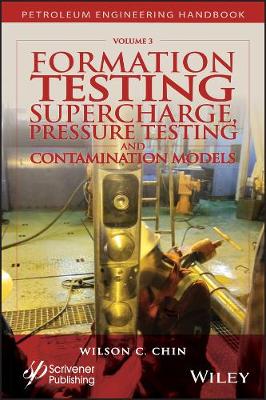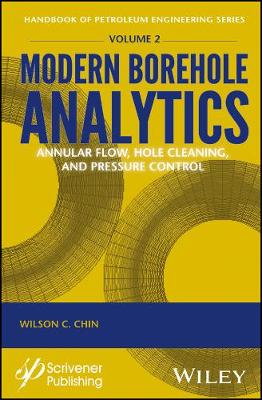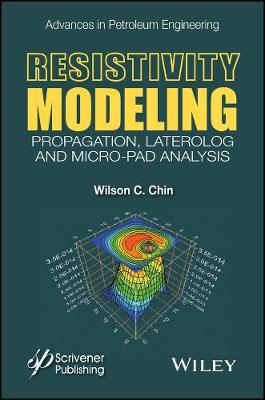Advances in Petroleum Engineering
6 total works
Wave Propagation in Drilling, Well Logging and Reservoir Applications
by Wilson C. Chin
Wave propagation is central to all areas of petroleum engineering, e.g., drilling vibrations, MWD mud pulse telemetry, swab-surge, geophysical ray tracing, ocean and current interactions, electromagnetic wave and sonic applications in the borehole, but rarely treated rigorously or described in truly scientific terms, even for a single discipline. Wilson Chin, an MIT and Caltech educated scientist who has consulted internationally, provides an integrated, comprehensive, yet readable exposition covering all of the cited topics, offering insights, algorithms and validated methods never before published. A must on every petroleum engineering bookshelf! In particular, the book:
Delivers drillstring vibrations models coupling axial, torsional and lateral motions that predict rate-of-penetration, bit bounce and stick-slip as they depend on rock-bit interaction and bottomhole assembly properties,Explains why catastrophic lateral vibrations at the neutral point cannot be observed from the surface even in vertical wells, but providing a proven method to avoid them,Demonstrates why Fermat's "principle of least time" (used in geophysics) applies to non-dissipative media only, but using the "kinematic wave theory" developed at MIT, derives powerful methods applicable to general attenuative inhomogeneous media,Develops new approaches to mud acoustics and applying them to MWD telemetry modeling and strong transients in modern swab-surge applicagtions,Derives new algorithms for borehole geophysics interpretation, e.g., Rh and Rv in electromagnetic wave and permeability in Stoneley waveform analysis, andOutlines many more applications, e.g., wave loadings on offshore platforms, classical problems in wave propagation, and extensions to modern kinematic wave theory.These disciplines, important to all field-oriented activities, are not treated as finite element applications that are simply gridded, "number-crunched" and displayed, but as scientific disciplines deserving of clear explanation. General results are carefully motivated, derived and applied to real-world problems, with results demonstrating the importance and predictive capabilities of the new methods.
Reservoir Simulation and Well Interference
by Wilson C. Chin and Xiaoying Zhuang
Co-written by a world-renowned petroleum engineer, this breakthrough new volume teaches engineers how to configure, place and produce horizontal and multilateral wells in geologically complicated reservoirs, select optimal well spacings and fracture separations, and how to manage factors influencing well productivity using proven cost-effective and user-friendly simulation methods.
Charged in the 1990s with solving some of petroleum engineering's biggest problems that the industry deemed "unsolvable," the authors of this innovative new volume solved those problems, not just using a well-published math model, but one optimized to run rapidly, the first time, every time. This not only provides numerical output, but production curves and color pressure plots automatically. And each in a single hour of desk time.
Using their Multisim software that is featured in this volume, secondary school students at the Aldine Independent School District delivered professional quality simulations in a training program funded by some of the largest energy companies in the world. Think what you, as a professional engineer, could do in your daily work. Valuable with or without the software, this volume is the cutting-edge of reservoir engineering today, prefacing each chapter with a "trade journal summary" followed by hands-on details, allowing readers to replicate and extend results for their own applications.
This volume covers parent-child, multilateral well, and fracture flow interactions, reservoir flow analysis, many other issues involving fluid flow, fracturing, and many other common "unsolvable" problems that engineers encounter every day. It is a must-have for every engineer's bookshelf.
This new volume, the third in Wiley-Scrivener's series on formation testing, reviews pressure transient interpretation and contamination analysis methods, providing numerous practical discussions and examples with rigorous formulations solved through exact, closed form, analytical solutions.
This new volume in the "Formation Testing" series further develops new methods and processes that are being developed in the oil and gas industry. In the 1990s through 2000s, the author co-developed Halliburton's commercially successful GeoTapTM real-time LWD/MWD method for formation testing, and also a parallel method used by China Oilfield Services, which enabled the use of data taken at early times, in low mobility and large flowline volume environments, to support the important estimation of mobility, compressibility and pore pressure, which are necessary for flow economics and fluid contact boundaries analyses (This work was later extended through two Department of Energy Small Business Innovation Research awards.).
While extremely significant, the effect of high pressures in the borehole could not be fully accounted for. The formation tester measures a combination of reservoir and mud pressure and cannot ascertain how much is attributed to unimportant borehole effects. The usual approach is "simply wait" until the effects dissipate, which may require hours, which imply high drilling and logging costs, plus increased risks in safety and tool loss. The author has now modeled this "supercharge" effect and developed a powerful mathematical algorithm that fully accounts for mud interations. In short, accurate predictions for mobility, compressibility and pore pressure can now be undertaken immediately after an interval is drilled without waiting.
This groundbreaking new work is a must-have for any petroleum, reservoir, or mud engineer working in the industry, solving day-to-day problems that he or she encounters in the field.
Modern Borehole Analytics – Annular Flow, Hole Cleaning, and Pressure Control
by Wilson C. Chin
Wilson C. Chin has written some of the most important and well-known books in the petroleum industry. These books, whose research was funded by the U.S. Department of Energy and several international petroleum corporations, have set very high standards. Many algorithms are used at leading oil service companies to support key drilling and well logging applications.
For the first time, the physical models in these publications, founded on rigorous mathematics and numerical methods, are now available to the broader industry: students, petroleum engineers, drillers and faculty researchers. The presentations are written in easy-to-understand language, with few equations, offering simplified explanations of difficult problems and solutions which provide key insights into downhole physical phenomena through detailed tabulations and color graphics displays. Practical applications, such as cuttings transport, pressure control, mudcake integrity, formation effects in unconventional applications, and so on, are addressed in great detail, offering the most practical answers to everyday problems that the engineer encounters.
The book does not stop at annular flow. In fact, the important role of mudcake growth and thickness in enabling steady flow in the annulus is considered, as is the role of (low) formation permeability in affecting mud filtration, cake growth, and fluid sealing at the sandface. This is the first publication addressing "the big picture," a "first" drawn from the author's related research in multiple disciplines such as drilling rheology, formation testing and reservoir simulation. A must-have for any petroleum engineer, petroleum professional, or student, this book is truly a groundbreaking volume that is sure to set new standards for the industry.
Supercharge, Invasion, and Mudcake Growth in Downhole Applications
by Wilson C. Chin
Mysterious "supercharge effects," encountered in formation testing pressure transient analysis, and reservoir invasion, mudcake growth, dynamic filtration, stuck-pipe remediation, and so on, are often discussed in contrasting petrophysical versus drilling contexts. However, these effects are physically coupled and intricately related. The authors focus on a comprehensive formulation, provide solutions for different specialized limits, and develop applications that illustrate how the central ideas can be used in seemingly unrelated disciplines. This approach contributes to a firm understanding of logging and drilling principles. Fortran source code, furnished where applicable, is listed together with recently developed software applications and conveniently summarized throughout the book. In addition, common (incorrect) methods used in the industry are re-analyzed and replaced with more accurate models, which are then used to address challenging field objectives.
Sophisticated mathematics is explained in "down to earth" terms, but empirical validations, in this case through Catscan experiments, are used to "keep predictions honest." Similarly, early-time, low mobility, permeability prediction models used in formation testing, several invented by one of the authors, are extended to handle supercharge effects in overbalanced drilling and near-well pressure deficits encountered in underbalanced drilling. These methods are also motivated by reality. For instance, overpressures of 2,000 psi and underpressures near 500 psi are routinely reported in field work, thus imparting a special significance to the methods reported in the book.
This new volume discusses old problems and modern challenges, formulates and develops advanced models applicable to both drilling and petrophysical objectives. The presentation focuses on central unifying physical models which are carefully formulated and mathematically solved. The wealth of applications examples and supporting software discussed provides readers with a unified focus behind daily work activities, emphasizing common features and themes rather than unrelated methods and work flows. This comprehensive book is "must" reading for every petroleum engineer.
Resistivity logging represents the cornerstone of modern petroleum exploration, providing a quantitative assessment of hydrocarbon bearing potential in newly discovered oilfields. Resistivity is measured using AC coil tools, as well as by focused DC laterolog and micro-pad devices, and later extrapolated, to provide oil saturation estimates related to economic productivity and cash flow. Interpretation and modeling methods, highly lucrative, are shrouded in secrecy by oil service companies – often these models are incorrect and mistakes perpetuate themselves over time.
This book develops math modeling methods for layered, anisotropic media, providing algorithms, validations and numerous examples. New electric current tracing tools are also constructed which show how well (or poorly) DC tools probe intended anisotropic formations at different dip angles. The approaches discussed provide readers with new insights into the limitations of conventional tools and methods, and offer practical and rigorous solutions to several classes of problems explored in the book.
Traditionally, Archie's law is used to relate resistivity to water saturation, but only on small core-sample spatial scales. The second half of this book introduces methods to calculate field-wide water saturations using modern Darcy flow approaches, and then, via Archie's law, develops field-wide resistivity distributions which may vary with time. How large-scale resistivity distributions can be used in more accurate tool interpretation and reservoir characterization is considered at length. The book also develops new methods in "time lapse logging," where timewise changes to resistivity response (arising from fluid movements) can be used to predict rock and fluid flow properties.




